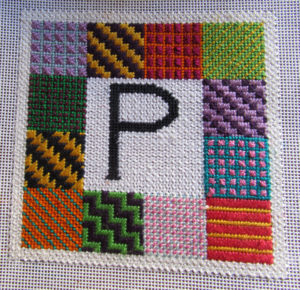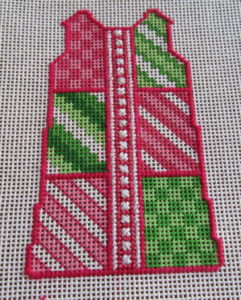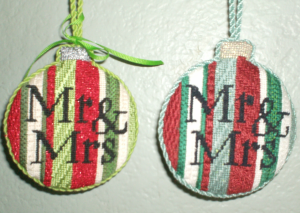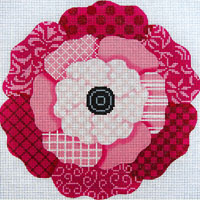
In this new series I’ll be looking at specific types of canvases you’ll find and talk about how to stitch them. The articles will be appearing on Thursdays. The number of articles on each topic will depend on the canvas and what there is to stitch. These are not stitch guides; they are designed to look at specific areas and types of canvases you’ll find. The first canvas is this shift, below, from Two Sisters (find it here). It’s an example of a canvas where the stitches are painted onto the canvas. The picture frame above is another Two Sisters canvas of this type (buy the stitch guide here).

These canvases can be so fun for stitchers at any level. For beginners, they give you a wonderful way both to learn and get familiar with a number of different stitches while having a guide to make them. For more advanced stitches they are a great way to remember old stitches and to give you creative but stressless stitching. If you stitch on the go, with the stitches painted on, you don’t need a stitch guide — the guide is on the canvas.
Painted stitches canvases are made by many designers, but not all canvases that have patterns painted on them are this type of canvas. In order to be a painted stitches canvas, the patterns on the canvas must be those of actual stitches. For example, most checks are painted stitches because squares can be Mosaics, Scotch Stitches, or Rhodes Stitch (variations included), but many straight stripes are not. That’s because, depending on the width, the stripe may fit several units of the stitch in one direction.
Looking at the shift, we see diagonal stripes, stepped patterns, and checks. Having many patterns on the canvas is typical of painted stitches canvases. You all see in both these canvases that there is more than one color in each area, often with a strong contrast. This is necessary so that you see the pattern of a stitch. Solid areas are not painted stitches.
There are some things to look out for that either are not painted stitches or make these canvases harder to do.:
-
circles – there are very few circular stitches, so having these limits your choices
identifiable motifs – designs with identifiable things such as candy canes or fish in areas as a pattern are not painted stitches
animal skins – these are irregular and not painted stitches.
fabric patterns – if it looks like a man’s tie or a damask tablecloth, it rarely is a patterned stitch
plaids – these are almost patterned stitches but they are stitched with a different technique called needlepoint plaids.
Focal Points
A focal point is important for every needlepoint. It’s the place where their viewer’s attention is focuseed. With the many patterns, colors, and stitches in these designs can make for a chaotic look. Having a focal point brings order to the design.
In the monogram frame, the initial is the focal point. If I had finished it as a picture frame, the photo would be the focal point. In the shift the column of squares down the center in the focal point. I have accented it by using metallic and metallic blend threads and will be adding overstitching to the squares.
Below you’ll find some additional painted stitches canvases with information about their focal points.

Although this is a striped canvas, I treated it as a painted stitches canvas (stitch guide available here). The focal point is the text.

This JP Needlepoint flower has many painted stitches. The focal point in the black flower center. The light area surrounding the center helps draw attention to it. When stitching you could further enhance the focal point by picking a bold stitch such as turkeywork for the center.

This vintage painted stitches canvas does not have a focal point as it is painted. I only discoverd this as I was stitching. By choosing metallic threads for the striped patch near the center, I will be making a focal point.
Next week, I’ll talk about checked spaces and stitches to use in them.
About Janet M Perry
Janet Perry is the Internet's leading authority on needlepoint. She designs, teaches and writes, getting raves from her fans for her innovative techniques, extensive knowledge and generous teaching style. A leading writer of stitch guides, she blogs here and lives on an island in the northeast corner of the SF Bay with her family

What is the best medium to use to hand paint on Needlepoint canvas?
Use acrylic paints. If you are painting for yourself only, you can use the inexpensive crat acrylics in bottkes. If you are painting commercially, you could also use the more expensive artist acrylics from Golden or Liquidtex.
Keep stitching,
Janet